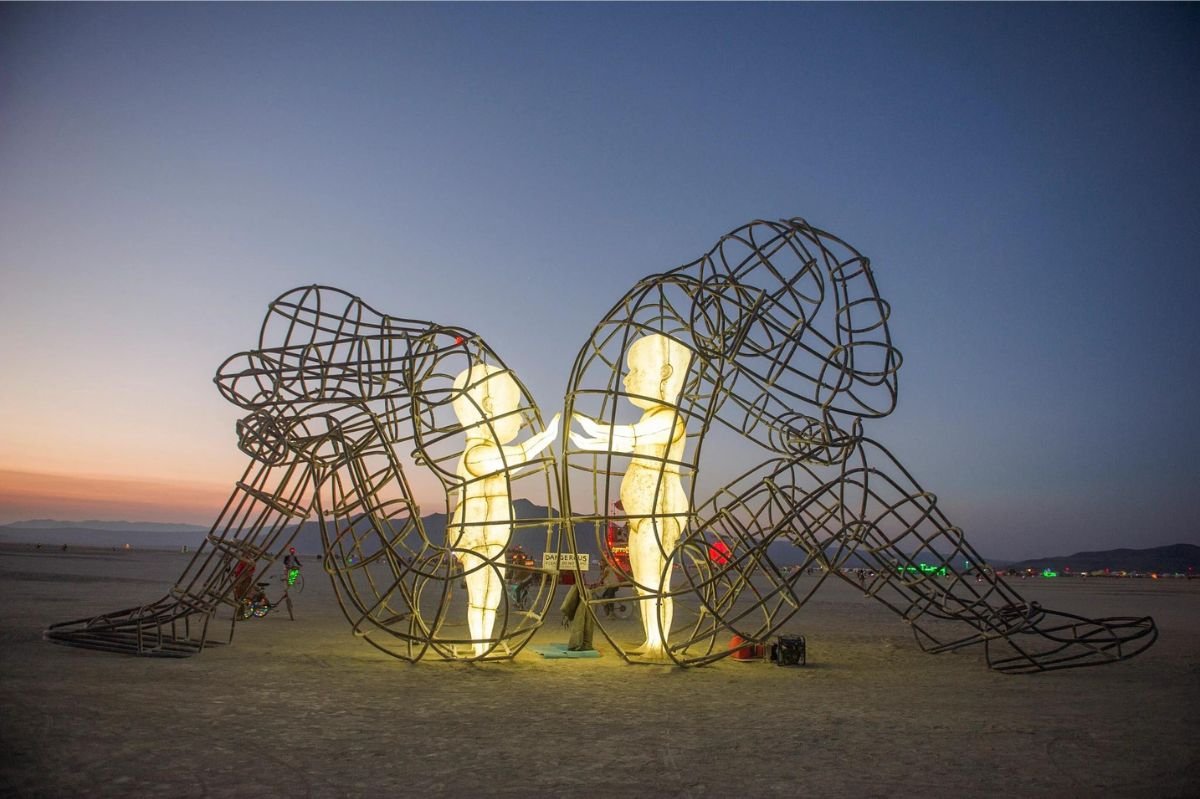Your Inner Child and You
Below is a picture of a beautiful sculpture titled “LOVE” by Ukrainian artist, Alexander Milov, that features two wire-frame adults sitting back to back with their inner children reaching out to each other from within.
LOVE is a sculpture by Alexandr Milov. It demonstrates a conflict between a man and a woman as well as the outer and inner expression of human nature. The figures of the protagonists are made in the form of big metal cages, where their inner selves are captivated. Their inner selves are executed in the form of transparent children , who are holding out their hands through the grating. As it’s getting dark (night falls) the children chart to shine. This shining is a symbol of purity and sincerity that brings people together and gives a chance of making up when the dark time arrives. Photo taken by Lung Liu, 2015. From https://burningman.org/
I have seen many pictures of this sculpture over the years and even from the first time I saw it, the image stayed with me. This sculpture beautifully captures our inner child wanting to connect but how sometimes our adult selves get in the way, or just don't know how to connect. This illustrates how it can be a challenge to connect with others when there has been past hurts, wounds, trauma and unmet needs.
The good news is we can learn how to recognize this deeper part of ourselves. We can heal and care for our inner child. Then, we can develop deeper connections and intimacy in our relationships when we do!
First, what is an inner child? We all have one. Your inner child is a part of your subconscious that holds many of your early childhood experiences, wounds, emotions and traumas. This part of you has been with you all your life and has gathered messages about who you are, about others and the world around you. These messages come from people explicitly speaking to or around you, from experiences, your thoughts or feelings about those experiences and from culture.
As we grow up, we start to cognitively disconnect from the inner child, yet the inner child still dictates some of our thoughts, feelings and behaviors. The inner child moves into our subconscious meaning we are less aware of this part of ourselves and ultimately the thoughts and feelings connected with this part of us. Have you ever wondered why you acted a certain way? Why something bothered you so much or why you felt an emotion in response to something that didn’t quite make sense to you. That is likely because your inner child informed your thoughts, feelings and ultimately, behavior. When we are not aware of the inner child’s unresolved wounds or unmet needs, we won’t recognize how the present moment is connected to the past. We also won’t realize the messaging the inner child has gathered is informing our perspective, thoughts or feelings. An additional risk is that we might unintentionally continue to wound or not meet the needs of our own inner child.
The inner child wounds are connected to one or more of the following:
To feel safety (emotionally and physically)
To feel loved and connected
To have other needs met (emotional, physical, psychological)
If you were abandoned in any way as a child, or perceived you were, your inner child is still highly sensitive to abandonment or the threat of being abandoned. You might have a tendency to end relationships before the other person has a chance to leave you. You might be more emotionally reactive if someone “ghosts” you or distances from you. You might be more hesitant or reluctant to enter into relationships for a fear of abandonment.
These childhood experiences of abandonment help to create your belief system (about yourself, others and the world around you) which will then inform your thoughts (ex: I am not loveable, people will always leave me), feelings (ex: lonely, shame, fear, sadness, anxiety) and behaviors (high walls in relationships, lack of close/intimate relationships, limited or lack of vulnerability and connection in relationships).
So how do we heal and care for the inner child?
Your inner child needs safety and security. Identifying the wounds and trigger points for your inner child is helpful so you can directly attend to these feelings and connected needs (do you need more kindness if a wound in childhood was a high volume of criticism? Or do you need to honor and validate your emotions if you grew up in a home that didn’t allow for or provide space for your emotions?)
Identify the messaging. What are your thoughts about the situation? What is the story you are telling yourself?
Practice mindfulness (simply put, being present) so that you can be aware of your thoughts, feelings and behaviors to see if any are connected to old wounds and unmet needs. What is the underlying need: safety, love and belonging?
Seek professional help to gain more insight and understanding of your inner child, any wounds or unmet needs that need healing.
Coming soon to the blog is a feature on Your Inner Child and Your Relationships.
If you’ve been debating counseling or therapy, Swell is here for you. Sign up today with one of our licensed therapists. We’re

